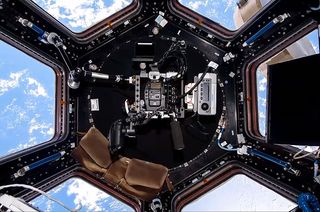Astronauts Filming New IMAX Movie Deliver 'Deluge of Beautiful Images'

Astronauts on the International Space Station are about a third of the way through filming scenes for a new IMAX documentary to be released next year, the film's director revealed in a new interview.
Toni Myers, the filmmaker behind "Hubble 3D" and IMAX's other shot-in-space giant screen movies, gave an update about her new project in a NASA interview on Wednesday (March 4). IMAX and Walt Disney Studios Motion Pictures announced two years ago that they were collaborating with NASA to produce a movie that would "offer breathtaking, illuminating views of our home planet from space."
"The IMAX project is a film about our planet and our future on it and off it," Myers told a NASA commentator at the Marshall Space Flight Center in Huntsville, Alabama. "We have a long history, IMAX does, of taking pictures in orbit and [the station] is the best platform we know for studying the changes that are occurring to our planet right now." [IMAX Movies in Space: A Photo Tour]
NASA astronauts Butch Wilmore and Terry Virts were the first of five space station crew members trained to take a turn behind the camera for the movie, tentatively titled "A Perfect Planet."
"The crew's doing an absolutely wonderful job," Myers told NASA's Lori Meggs. "We're deluged with beautiful images that [Expedition 42] commander Butch Wilmore and Terry Virts are sending down."
Wilmore has been filming scenes for Myers since arriving at the orbiting outpost in September. He is set to hand off command of the space station to Virts on Tuesday (March 10) before boarding a Russian Soyuz spacecraft to return to Earth the next day. Virts will stay on-orbit through May.
"Scott Kelly will be flying up," Myers said, referencing the NASA astronaut who will begin a year-long expedition on the space station later this month. "He is our next trained crew to go up. Then after Scott, will be Kjell Lindgren and Kimiya Yui from Japan. We have had great fun training all those guys."
Get the Space.com Newsletter
Breaking space news, the latest updates on rocket launches, skywatching events and more!
In the past, when the space shuttle was flying, IMAX flew large 2D and 3D cameras that recorded footage on large reels. With the retirement of the winged orbiters four years ago, Meyers and her team had to come up with another way for the astronauts to film.
"These [are] brand new cameras," Myers described. "We weren't allowed to fly traditional cameras because there is no up-mass to get those big cameras — well, it is not so much the cameras but getting film back and forth — we just can't do it anymore."
These new, more compact cameras — specifically, Canon EOS C500 EF digital cinema cameras — were flown to the space station on SpaceX Dragon cargo vehicles that launched last September and in January.
"The Canon EOS C500's image quality was more film-like than the other systems," James Neihouse, the director of photography for "The Perfect Planet," said in a statement. "The sharpness is superior to some of the larger sensors. And it is more user-friendly for the astronauts. We have a good track record with Canon cameras in space."
The astronauts are using the cameras to film scenes out the window, as well as of their activities inside the orbiting laboratory.
"We've one component of the film, which is the principal one, the Earth views," stated Myers. "But we also shoot interiors in the space station of the research that is going on, especially with a view to longer duration spaceflights to other planets [and] what we're learning about that."
"We also do daily life scenes, how a crew lives in a closed system such as the station," she added.
The remaining two-thirds of the film will be shot in space between now and September. Then Myers will get to work on editing the footage into the finished documentary.

"I have to deliver a finished film into theaters in late spring of 2016. That may seem like a healthy amount of time, but when you're making a film, it is not at all. It is pedal to the metal from here on in," she said.
As for the movie itself, Myers has high hopes for the final product.
"It's my hope of course that it is the most popular," Myers told NASA's Meggs. "We've enjoyed an amazing success and that's because human beings pretty much universally are curious about space and the environment around our planet, things that most of us cannot experience except through the magic of IMAX."
Click through to collectSPACE to watch NASA's interview with IMAX director Toni Myers.
Follow collectSPACE.com on Facebook and on Twitter at @collectSPACE. Copyright 2015 collectSPACE.com. All rights reserved.
Join our Space Forums to keep talking space on the latest missions, night sky and more! And if you have a news tip, correction or comment, let us know at: community@space.com.

Robert Pearlman is a space historian, journalist and the founder and editor of collectSPACE.com, an online publication and community devoted to space history with a particular focus on how and where space exploration intersects with pop culture. Pearlman is also a contributing writer for Space.com and co-author of "Space Stations: The Art, Science, and Reality of Working in Space” published by Smithsonian Books in 2018. He previously developed online content for the National Space Society and Apollo 11 moonwalker Buzz Aldrin, helped establish the space tourism company Space Adventures and currently serves on the History Committee of the American Astronautical Society, the advisory committee for The Mars Generation and leadership board of For All Moonkind. In 2009, he was inducted into the U.S. Space Camp Hall of Fame in Huntsville, Alabama. In 2021, he was honored by the American Astronautical Society with the Ordway Award for Sustained Excellence in Spaceflight History.
Most Popular



